We spent last night on the sleeper train from Sapa back to Hanoi. “Sleeper” is a bit of a misnomer, as it is pretty hard to get much sleep while being nearly tossed out of your bunk each time you pull into or out of a station, which happens a couple times an hour during the night.
We were met at the door of the train by Qyuet (“just call me ‘Q’), the True Believer who had led us in Hanoi earlier. While other tourists were forced to navigate the rather awkward way back to the station on their own, it was nice to have Q there, helping us with our (way too much) luggage around the other trains on the tracks, and finally into our waiting car.
If you remember, Q was giving us The Party Line so solidly in Honoi that I quickly began to discount most “facts” that he told us (Vietnam has zero unemployment, zero poverty, perfect health care, and its people are always kind and stop for pedestrians crossing the street, etc). After leaving the train, we immediately left Hanoi for Halong Bay, several hours drive from the city. As we left Hanoi behind, we seemed to also leave the True Believer. To my surprise, we started hearing a more believable story of the country from Q.
First, Q apologized for the condition of the trains (before we said anything about how rough the ride was), explaining that they were made “during the French period” (a phrase we heard a lot, which meant before 1954, when Vietnam was a French colony), and has not been maintained since. He then also told us of a project he did in college in the hill country (where we had just left, and which I found largely distasteful), in which his team taught them how to create homestays, and how to create an economy that would build for the future. He helped teach them the importance of education for advancing the family and the village.
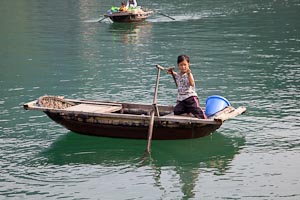 He then said that after a few years of project completion, he went back and saw they had reverted to their old ways, and had mostly lost the benefits of the training. He lamented that the hill people were only concerned with “making the most money today” while ignoring “the value of building a stronger village for the future.” Unfortunately, that coincided very closely with what we saw the prior two days up in the hills.
He then said that after a few years of project completion, he went back and saw they had reverted to their old ways, and had mostly lost the benefits of the training. He lamented that the hill people were only concerned with “making the most money today” while ignoring “the value of building a stronger village for the future.” Unfortunately, that coincided very closely with what we saw the prior two days up in the hills.
He also told us that all kids went to school in the hills. However, he said most kids wait for the morning snacks that are given free, then immediately leave after being fed, having no interest in actually learning anything.
We stopped at an artist workshop manned entirely by disabled people, and found the work to be absolutely astonishing quality. We are not in the market for anything like this, but there was stunning statuary, embroidery, lacquer work, and fabrics. We watched women creating embroidery of photo-realistic images that I would have been proud to produce with my camera.
Tuesday, Oct 25
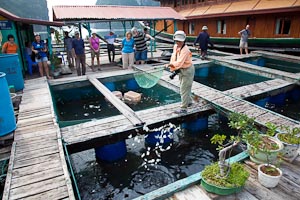 We went to Halong Bay and spent the night on a junk named Hsiong Hai. The food was gourmet, and looked as good as it tasted. Only after the fact did we realize we should have been photographing the food. It was a treat for the eyes as much as the tongue. After missing photographing both lunch and dinner, we decided we would bring our camera to breakfast. Unfortunately, that meal was more ‘normal’ and not really much of a photographic topic, though it still was quite delicious. Opportunity missed…
We went to Halong Bay and spent the night on a junk named Hsiong Hai. The food was gourmet, and looked as good as it tasted. Only after the fact did we realize we should have been photographing the food. It was a treat for the eyes as much as the tongue. After missing photographing both lunch and dinner, we decided we would bring our camera to breakfast. Unfortunately, that meal was more ‘normal’ and not really much of a photographic topic, though it still was quite delicious. Opportunity missed…
The tour description had said we would visit a “fishing village” the next morning, and I had several images in mind that I hoped to capture, of fishing boats with nets extended, and fishermen throwing their nets. Unfortunately, this was one of those cases of poor translation. It was not a “fishing village” but rather a “fish farm” with a couple dozen ‘holes in the water’ where different fish were being farmed for restaurant consumption. Very little to photograph. Kids came up on boats and then rubbed their fingers together to indicate they wanted us to pay them. Begging even here out on the water… (Something we only saw in North Vietnam — never in South Vietnam or Cambodia)
There was also to be a “large cave walk.” I guess ‘large’ is a relative term though, as we have walked through much larger and more impressive caves elsewhere in the world. That walk did not result in any ‘keeper’ photographs either.
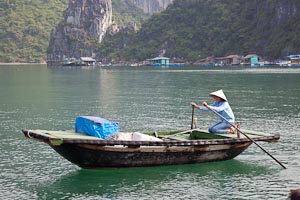 All in all, it was a pleasant overnight on a boat with excellent food, but pretty much a loss for photography. We were told that the actual fishing boats have been gone for years as the tourist boats have made the local waters no longer good fishing grounds. Another example of where it appears we are a decade too late for visiting Vietnam.
All in all, it was a pleasant overnight on a boat with excellent food, but pretty much a loss for photography. We were told that the actual fishing boats have been gone for years as the tourist boats have made the local waters no longer good fishing grounds. Another example of where it appears we are a decade too late for visiting Vietnam.
While on the junk, we asked the manager for suggestions on where to stop on the way back to Hanoi, since we were looking at several hours waiting at the airport if we just drove straight there. We could not get him to give any suggestions, and instead he kept saying he wasn’t sure what our guide had arranged. We didn’t really understand the issue until later. When driving back, we told Q that we wanted to stop by a village to see rice farming, since the crop was being brought in that day.
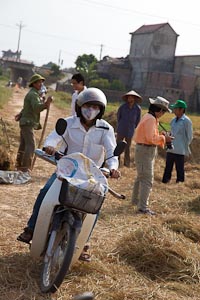 That was when it finally became clear — we were not allowed to visit any village or store unless we first had clearance and permission from the government. We hadn’t even realized up until then just how constrained our travels had been. As we later confirmed with other guides, the Vietnam government only allows foreigners in select locations, and any deviation requires advance permission from the government. Quick reminder that this is a fully Socialist government, with the same restrictions we saw in Russia, China and Burma in the past…
That was when it finally became clear — we were not allowed to visit any village or store unless we first had clearance and permission from the government. We hadn’t even realized up until then just how constrained our travels had been. As we later confirmed with other guides, the Vietnam government only allows foreigners in select locations, and any deviation requires advance permission from the government. Quick reminder that this is a fully Socialist government, with the same restrictions we saw in Russia, China and Burma in the past…
I asked Q about the odd shape of most homes we passed. There were wide fields with lots of land available, but the homes were very narrow. They went deep, and were often several floors high (2 or 3), while only 16 feet wide (4 to 5 meters) at most. Seemed bizarre from American housing standards. Turns out the homeowners have to pay a home 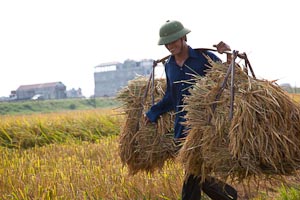 tax based on the width of the house. Not on the livable space, but on the width. Thus, people make their houses as narrow as possible. Another humorous example of unintended consequences, and how people will always find a way to minimize taxes, regardless of where in the world they live, or under what government structure.
tax based on the width of the house. Not on the livable space, but on the width. Thus, people make their houses as narrow as possible. Another humorous example of unintended consequences, and how people will always find a way to minimize taxes, regardless of where in the world they live, or under what government structure.
